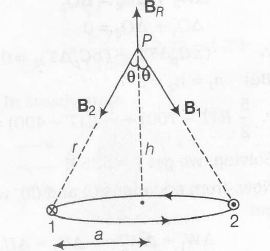Answer:
Option C
Explanation:
BR =B due to ring

B1 = B due to wire-1
B2= B due to wire -2
In magnitudes
B1 =B2 = $\frac{\mu_{0}l}{2\pi r}$
Resultant of B1 and B2
$=2B_{1}\cos \theta =2\left(\frac{\mu_{0}l}{2\pi r}\right)\left(\frac{h}{r}\right)$
= $\frac{\mu_{0}lh}{\pi r^{2}}$
$B_{R}=\frac{\mu_{0}lR^{2}}{2(R^{2}+X^{2})^{3/2}}$
$=\frac{2\mu_{0}l\pi a^{2}}{4\pi r^{3}}$
As , R=a ,x=h and a2+h2=r2
For zero magnetic field at P.
$\frac{\mu_{0}lh}{\pi r^{2}}=\frac{2\mu_{0}l\pi a^{2}}{4\pi r^{3}}$
$\Rightarrow$ $ \pi a^{2}=2rh\Rightarrow$ h≈1.2 a